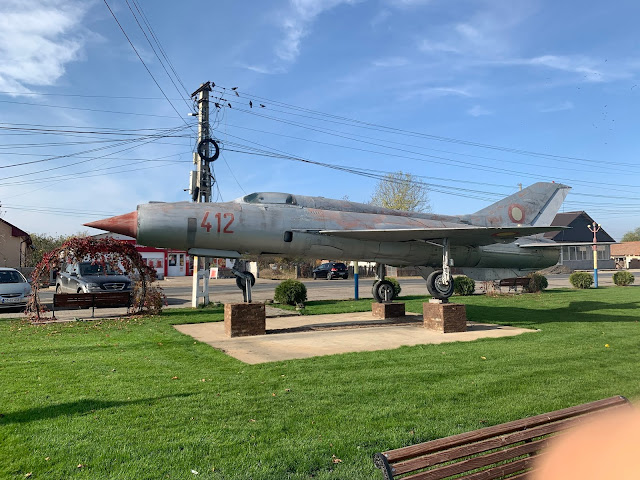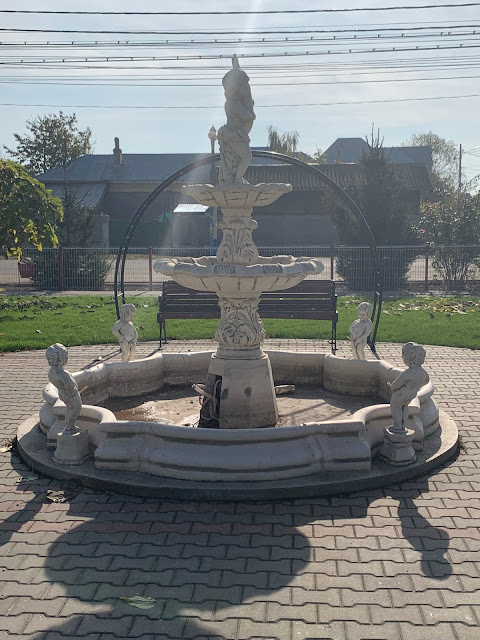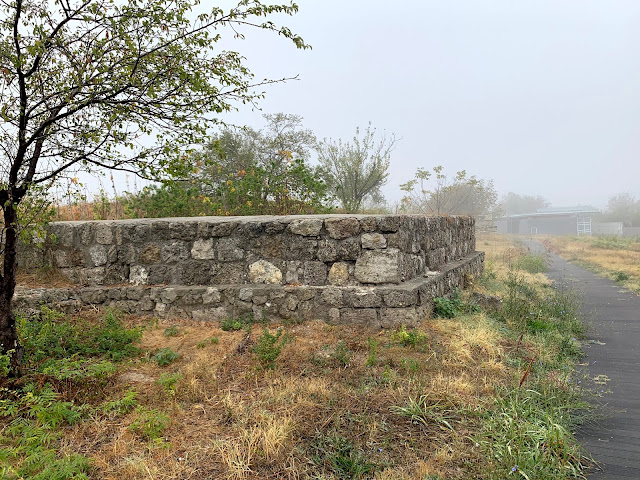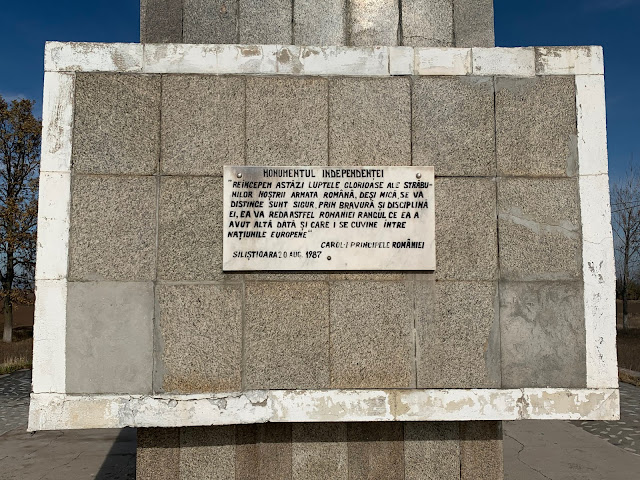Whenever you travel to Naval Support Facility Deveselu, you always approach from the north (because we're about as south as you can go in Romania without being in Bulgaria)! So you drive toward the base and always take a left every time, to enter the base. Well, I've wondered since I arrived here, "what if I just went straight, where would the road take me?" So I did. I've been to the village of Corabia twice now, once with the CO, Captain Jack Knick, and now with my new N64, Charles Morrison. When the CO and I went, it was a VERY foggy Saturday morning so there were some sites we couldn't see through the fog. So I enlisted Charles to come with me a couple Saturday's later but this time it was a beautiful day.
Ok, I couldn't resist. As we entered Corabia, I saw this Mikoyan-Gurevich (MiG-21 Fishbed) on display in their local park. This is a supersonic jet fighter and interceptor aircraft, designed by the Mikoyan-Gurevich Design Bureau in the Soviet Union. It was produced from 1959 - 1985 and is still flown by some nations. I'm pretty sure this one will never fly again but it's pretty cool.
Right across from the MiG was this cute fountain. I wish the little cherub dudes were operational but I think, with winter at the doorstep, it is turned off for the season.
THE VILLAGE OF CORABIA AND THE SUCIDAVA FORTRESS
Corabia is a village on the Danube River located about 21 miles (34 km) south of the base. It is home to one of the largest Roman-Byzantine fortresses in Oltenia (one of the six Romania 'regions') built after the Roman conquest of Dacia. The Sucidava Fortress dates back to the 3rd-6th centuries AD. It is located three miles (five km) west of the town of Corabia, Olt County, Celei village.
Because of its immediate proximity to the Danube, Corabia was once an ancient military and economic center of the Suci tribe who had settled here. During the reign of Constantine the Great, the Romans built a massive bridge over the Danube, the remains of which (if you know where to look) you can still see today.
Note: Anyone who has read my entries knows I'm not satisfied with just telling you what I did, I want you to know what I did, where I did it, and the historical significance of the location.
When I arrived at Sucidava, the first thing you are greeted with is a small park and signs telling the story of the fortress.
The sheer scale of the site will amaze you. The walls are very well preserved and the uncovered areas will help you imagine the fortress at its height, when it was teaming with life. I told Charles I can close my eyes and see, nearly 2,000 years ago, people working and living here. It is large enough for several hundred people to occupy. Sucidava Fortress covers an area of about 2.368 million square feet (220,000 m2). To put this in perspective, the average Walmart Supercenter is 179,000 square feet. This means the Sucidava Fortress is over 13 times larger than your neighborhood Walmart!
After being destroyed by the Huns, Byzantine Emperor Justinian restored the fortress during the time of between 527 - 535 AD. Archeological digs at the site prove sometime after 602 AD there were Dacians, Romans, and later Romanians all lived here. Modern day Sucidava, once known as Celei village, was first documented in 1247 in documents related to the Knights Hospitaller (Knights Hospitaller - pretty cool reading).
Many items uncovered around the fortress are on display in the Ethnographic and Archeological Museum in Corabia (I need to find this still but I'll need the help of a Romanian friend).
The signage throughout the site tells me, included in the fortress remains are: the tell-shaped settlement with 11 phases of inhabitation; remnants of a Geto-Dacian residence; the Roman well from the 2nd century AD; the Roman-Byzantine Fortress; the portal of Constantine the Great’s bridge over the Danube; the West Gate; a building from the 4th-5th centuries; the building with a hypocaust; the Secret Well (6th century); the Paleo-Byzantine Christian Basilica; and the Tower Pillar of Constantine’s Bridge*.
*Constantine the Great was also known as Constantine I. He was a Roman Emperor who ruled between 306 and 337 AD. Born in Naissus (west of Sucidava), in Dacia Ripensis (south of the Danube), the city now known as Niš (Bulgaria) (see above). He was the son of Flavius Valerius Constantius, a Roman Army officer of Illyrian origins, and his mother, Helena, was Greek. Constantine the Great is best known for being the first 'Christian' Roman emperor; his reign was a turning point for the Church. Scholars debate whether Constantine adopted his mother's Christianity during his youth, or whether he adopted it gradually over the course of his life. In any case, when he became the sole ruler of the Western Roman Empire, he issued the Edict of Milan in 313, which guaranteed religious tolerance for Christians (thought to have been influenced by St Helena). In 323, he became the sole ruler of the entire Roman Empire and extended the provisions of the Edict of Milan to the Eastern half of the Empire. Finally, with over three hundred years of persecution behind them, Christians could finally practice their faith in peace. The Edict was very sweeping, including several clauses stating current occupants would return all confiscated churches (as well as other provisions) to previously persecuted Christians. He also made new laws regarding Jews, forbidding them to own Christian slaves or to circumcise them.
THE SUCIDAVA FORTRESS
A small Christian church or basilica with 25.5 inch (65 cm) thick walls made of stone, brick, and mortar remains from the early Christian period. Six graves were discovered under the floor, all of them oriented east to west in the traditional Christian manner. One is of an elderly man. We couldn't see these because the graves are protected by a locked large metal cover.
A special site we wished we could see is the 59 foot (18 m) deep well. Unfortunately it was closed.
The main landmark of the site is the Secret well, which is considered to be quite unique in its construction. Decorated back in the 6th century, it was rediscovered in 1958. It was given its distinctive name because of the water source – an underground spring, 46 feet (14 m) outside the fortress. From what I've read, historians believe it was constructed during the restoration of the fortress at the time of Emperor Justinian and has been in use since then. It is made from red terra cotta-like tiles which were preserved after the restoration. It is equipped with ventilation openings which are still functional. One of the explanations for its construction is in the 6th century, a clean water supply to the military and their families in the Sucidava garrison was very difficult. The fortress was built too high up on a hilly embankment to build a standard well and the layers of sand and gravel beneath the structure would crumble from the digging. Using the wells 85 foot (26 m) long tunnel, the people inside the fortress could easily get water underground without the enemy knowing about it.
I have read, todays visitors who have the opportunity to go through the tunnel, can see black spots on the walls where torches once lit the well. A local custom, exists even to this day, states on her wedding day, the bride should come here and drink “living water” from this well so the marriage is full of love. This is why local Romanians call the Secret fountain the Love Spring. They also say the water is still drinkable and "pure as a tear."
 |
| Hypocaust |
The hypocaust deserved to be mentioned here, a 36 foot (11-meter) long thermal chamber (4-5 century AD) which used to provide floor heating and of which only the foundation remains. Warm air from a furnace outside the building circulates in the space between the floor and the base of the stairs. This is how this important structure, a command center, was heated. Hypocaust, in building construction, is an open space below a floor heated by gases from a fire or furnace below awhich allows the passage of hot air to heat the room above. This type of heating was developed by the Romans, who used it not only in the warm and hot rooms of the baths but also almost universally in private houses in the northern provinces and, as we can see here, in their northern territories where it got very frigid.
In the distance you can see the Danube but I still couldn't find the darn bridge - maybe next time?
THE ROMAN BRIDGE FROM CORABIA
The bridge was built during the reign of the first Christian emperor, Constantine, and was inaugurated in the summer of 328. It stretched a length of nearly 8,000 feet (2437.5 m), often considered one of the longest bridges in antiquity. Though a marvel of construction, its life span was short until the end of the 4th century AD. It had a big role in uniting the Roman territories from the north and south of the Danube.
Of course, I had no way of knowing where it was located (the grounds keeper spoke absolutely no English and my Romanian was severely inadequate) so I have to find it another day. But the signs tell the ruins of the Roman bridge are about 130 feet (40 m) north of the bank of the Danube. I looked out from the fortress but I saw a swamp, a horse, and some sheep. Reportedly, the well preserved northern portal had the role of 'saw-picking', being built on a platform made of irregularly cut stone, bound with mortar. Today this is the only pillar left standing.
-------------------------------
We departed Corabia and headed east along the coastline of the Danube River, looking for the elusive bridge and the ferry which would take you to Bulgaria. We found neither. We did find this really cool statue which looks like it's straight out of the Communist Era. I had to capture a few pictures.
Monument of Independence
Today we begin the glorious battles of our ancient Romanian arm, although the ones will distinguish, I am sure, through her bravery and discipline, she will thus restore to Romania the rank that she once had and which she is worthy among the European nations.
King Carol I of Romania
Silistioara 20 Aug 1987
Across the street from the statue is a view of the Danube River with the Port of Corabia (primarily a grain distribution port) in the forefront - still no bridge....















































No comments:
Post a Comment